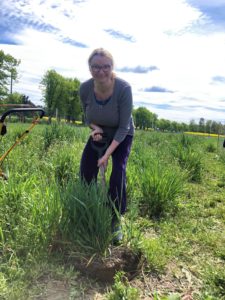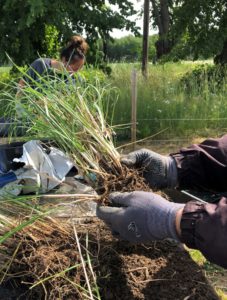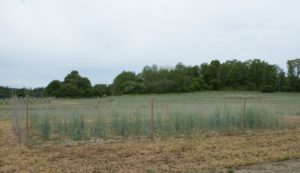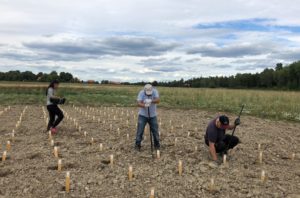Interview with Anna Westerbergh
This interview is part of a series that highlights the work of various individuals and organizations within the Kernza® network. Through these interviews, we aim to share and celebrate that there is a large and ever-changing ecosystem that moves Kernza® perennial grain forward. If you would like your organization’s work to be featured in an interview, please email Sophia Skelly. To learn more about the Kernza® network, visit our directory.
Can you give a brief overview of your work and how it intersects with Kernza® and perennial agriculture?
I am a biologist and plant geneticist at the Department of Plant Biology, Swedish University of Agricultural Sciences. It’s from that perspective that my research group and I attempt to contribute to perennial, sustainable agriculture. Ever since I studied biology at school, I have been really fascinated by the diversity and evolution of species, especially the evolution of plants. I received a Master’s degree in Biology at Umeå University, further north of Uppsala in Sweden and continued with plant genetics and evolution during my graduate studies.

I had the great opportunity to carry out my postdoctoral studies at the University of Minnesota. For about 3 years, I worked in Professor John Doebley’s lab. He dedicates his research to the evolution of maize. I studied the genetics of morphological and adaptive traits in wild relatives of maize. I made crosses between annual and perennial species and I evaluated traits related to perenniality in the offspring. So, that is when I became highly interested in perennial plants and I saw the potential of the wild relatives as genetic resources in the development of perennial crops. But I experienced that the scientific community was not yet ready, and did not show much interest in conducting research on developing perennial cereal grain crops.
When I later joined the Swedish University of Agricultural Sciences in Uppsala, it was a natural step to direct my studies towards the use of wild crop relatives. At first, I was mainly focusing on annual species. Then, after receiving my first grant on perennial crops, I got the opportunity – ten years later – to start to work on the development of perennial barley. And then some years later, I moved on to also work on the development of perennial wheat. For perennial wheat, my research group and I are mainly focusing on the breeding of Kernza® (domesticated intermediate wheatgrass, Thinopyrum intermedium), but we have also done some studies on wheat hybrids (offspring from crosses between wheat and intermediate wheatgrass). My main collaborators in this research are Mohammad Sameri and Per-Olof Lundquist at the Swedish University of Agricultural Sciences in Uppsala. I also have a PhD student working on the breeding of a perennial forage grass – Timothy grass, which is the major forage grass crop in Scandinavia. However, for the development of novel perennial cereal grain crops for Sweden and other regions with cold temperate climates, we are focusing on two candidates: a wild relative of barley called Hordeum bulbosum and Kernza®.
We have established field trials both north and south of Uppsala. Uppsala is in the central part of Sweden and the climate is very different from the climate in Kansas, Minnesota, and even in Manitoba in Canada, where the other breeding programs on Kernza® are carried out. We are using two different breeding strategies for the development of perennial barley, the domestication and the wide-hybridization strategies. Using the domestication strategy, we are trying to make the wild perennial barley species, Hordeum bulbosum, cultivable in our growing conditions in Sweden. We select for resistance to seed shattering and synchronized flowering, so called domestication traits, as well as good regrowth and adaptation to seasonal changes over several years. We have now reached the point where we are selecting the best performing genotypes as the parents of the next generation offspring. These offspring will make up our first breeding cycle of perennial barley.
We were also involved in an international study evaluating different wheat hybrids – hybrids between intermediate wheatgrass and different wheat species. We evaluated about 25 different hybrids here in central Sweden. And the same hybrids were also evaluated in 20 other sites, across four continents. Right now we are focusing our resources on Kernza® for the development of the first perennial grain cereal for cultivation in Sweden and other Nordic regions. In 2013, we planted our first plot of Kernza®, and those plants are still growing in the field. When we looked at their survival and re-growth and compared it with the performance of the wheat hybrids, we understood that Kernza® is the best candidate for the development of perennial wheat for Sweden. Of course, we need to adapt it to our growing conditions by using efficient selection and breeding methods, which is what we are doing now.
With an additional research grant, in 2018, we established 20 populations of intermediate wheatgrass from different geographical and genetic origins and we then initiated our breeding program on Kernza®. We are using a great diversity of plant material including seeds from the breeding programs at The Land Institute, University of Minnesota, and University of Manitoba. We have more than 3,000 unique genotypes that we are evaluating for traits related to regrowth, development and yield. Based on data from 2018 and 2019, we have done the first selection of parents for the next offspring generation. We have clonal trials of this material and we are very eager to evaluate those genotypes further and their offspring. This is where we are at right now in terms of breeding Kernza® for new cultivars that will be cultivated by Swedish and Scandinavian farmers, hopefully in the near future.
When did you first hear about Kernza®?

It was when I was working on the proposal for the development of perennial barley. Until then, my experience of grain cereals was from studies on barley and wheat and their annual wild relatives. Barley is the most cultivated cereal crop in northern Sweden and Scandinavia and we are working on improving its adaptation to waterlogging, and stress in general due to climate change. The aim of this project is to get more resilient barley cultivars for farmers in the northern part of Sweden. And since I am interested in developing perennial cereal grain crops, it was a natural step to start working on barley and its perennial wild relatives. I also knew that no one had really looked into this so I thought we could make a contribution by trying to direct our work towards an additional perennial cereal grain crop, besides Kernza® and perennial wheat hybrids.
In 2014, I was invited to the conference in Estes Park, Colorado, called New Roots for Ecological Intensification. Tim Crews was the main organizer, with other researchers at The Land Institute. At the conference, I learned much more about intermediate wheatgrass and I got the idea to include it in our research. The week after that, Lee, David, Wes and Shuwen generously and enthusiastically showed me all the fields at The Land Institute and described their research. I am really happy that I now have this opportunity to fulfill the dream I had when I did my postdoctoral research.
You were interested in perennial agriculture back in 2002; what was the reaction to it at the time?
I know that I had to fight very hard to be able to include a paragraph in one of the papers on the use of the wild relatives of perennial crops as genetic resources. I also discussed it with some plant breeders here in Sweden, and they were at that time not interested at all. They strongly suggested that I should focus more on the annual crops. That’s why I started to work on waterlogging tolerance in annual barley at first. But I tried to talk and discuss with people continuously. And it took some years to convince members of the research community that perennials are extremely important for the future of agriculture. Now, it has really changed. And there is a lot of interest here in Sweden. I would say that especially the younger generation of farmers really believe in this. They are just waiting for these perennial cultivars. I really think there is a great future for new perennial crops.
There is a lot of interest here in Sweden. I would say that especially the younger generation of farmers really believe in this. They are just waiting for these perennial cultivars. I really think there is a great future for new perennial crops.
And we also have to remember that the farmers already know how to cultivate perennial crops. Here in Sweden, I think about 30-40 percent of the arable land used for agricultural crops, is actually covered by perennial forage crops. The farmers already have the knowledge. The missing piece of the puzzle is perennial cereal grain crops, which is why we are working on adaptive breeding of intermediate wheatgrass and developing perennial grain crops such as perennial barley for Sweden.
To reach this goal, we really need long-term funding, but here in Sweden, the funding from both governmental and private research councils are short-term grants. I really hope to see more of a joint effort where several interested actors from the whole food chain could support our research towards perennial, sustainable agriculture and food production. I think that there are many actors that have sustainability on their agenda. We are trying to reach out with this message to these actors. I hope that in the near future, we can get more long-term funding, because the development of perennial cereal grain crops is a long-term commitment.
I hope that in the near future, we can get more long-term funding, because the development of perennial cereal grain crops is a long-term commitment.
The breeding of a new crop really benefits from breeding programs in various environments. Like I said earlier, here in Sweden, we have certain challenges, while in Kansas and other regions, there are other challenges. And we need to adapt the crops so they can produce good yields and be resistant to pathogens and weeds at the local and regional level.

So I really, really appreciate the interaction that we have with Lee DeHaan at The Land Institute, Jim Anderson at the University of Minnesota, Steve Larson at Utah State University and Doug Cattani at the University of Manitoba in Canada, and other coworkers experienced in breeding. I am really looking forward to the New Roots International global collaboration. We will have the opportunity to form networks and platforms that can focus on specific crops, and on specific themes. We can share experiences and knowledge. We can develop common methods and tools for more efficient breeding. I’m thinking about tools for both phenotypic and genomic selection. I know that Lee and Jim and their co-workers are developing improved genomic tools for breeding. And it would be important for our breeding work here in Sweden to be a part of that development. This is also why we have established new trials designed for this purpose and hope to contribute with an additional cultivation environment.
Is there anything about Sweden that relates to the cultural adaptation of perennial foods? Do you have any thoughts on the way that the culture around food and sustainability would relate to interest in Kernza® perennial grain?
Yes, absolutely. In Sweden, and in many places in the world, people are becoming more and more aware of climate change. We are in a crisis. Consumers and producers want to contribute to mitigating these climate changes. And I think people here in Sweden are very aware of the current situation and are turning more to alternative foods based on climate-smart crops. They are really interested in new crops and even new cropping systems, for example, intercropping legumes with Kernza® and with other cereals. We have also had the tradition for quite some time of eating healthier food like rye and whole grain bread. So, I can imagine us having shelves in grocery stores here in Sweden filled with products based on Kernza® and other perennial grain crops in the near future. I really see us moving in that direction. And because of the interest from the consumers, the farmers can see the potential in cultivating perennial grain crops. I think that the farmers also see that Kernza® and other perennial crops have many added values and benefits for agriculture and their farms due to their positive impact on the environment and climate, in contrast to annual crops. I know that many farmers are ready to include perennial cereal grains in their cropping systems earlier than many people would expect.
They also see economic value. For example, because they don’t need to sow the seeds and plow the fields every year, they will use less resources and spend less on machines, fuel and herbicides. And another value for the farmers is that these crops can be grown both as grain crops for human consumption and as forage crops. So, all these values must be included in the calculations of the economic value of a perennial crop. Farmers also have knowledge and experience of perennial cropping systems and this will be very important in the transition to perennial agriculture. It’s not a distant vision. It’s happening here in Sweden and I’m really happy to be a part of it.

Are there any unique challenges with breeding Kernza® for high latitudes?
Like any other crop, Kernza® needs to be cultivable, and give a reasonably good yield at the cultivation site. So that means that we need to find the best performing phenotypes in our growing conditions and make our own selections. Sweden covers seven cultivation and climate regions and we need to develop cultivars adapted to these regions. We therefore need to understand the diversity of the phenotypic traits in the intermediate wheatgrass populations we have established in central Sweden. We have found a great variation in all traits we are studying. As a geneticist and breeder, this is really what you want to see. And like I said earlier, based on this diversity we have made our first selection of the best performing genotypes as parents of the next generation and we will continue with these selections over plant generations to develop the first Kernza® for cold temperate regions. We have to give it some time and remind the farmers and consumers that once upon a time, the wild relatives of our annual crops had a very, very low yield. And through domestication starting 12,000 years ago followed by breeding during the last 200 years , we have reached the level of yield of annual barley and wheat which we have now. It’s easy to forget that even these crops have a history starting with the domestication of their wild ancestors like intermediate wheatgrass and the wild relatives of barley. But with modern breeding tools we will be able to develop new perennial crops much, much faster and we are already on the way to reaching this point.
Do you have any other plans or aspirations related to perennial agriculture?
The overall goal is, of course, to develop the first Kernza® and perennial barley cultivars for cultivation in Sweden and other Nordic regions. To be able to do that, we need more efficient breeding tools and long-term funding. Reaching the point where these cultivars will be grown at a larger scale will depend on the farmers–when they think the new cultivars are good enough to replace the old annual ones. In parallel to developing perennial grain cereals we need to find out how to cultivate these crops in Sweden; when and how to sow and when and how to harvest. It’s therefore very important to involve the farmers in our research and to include their perspectives into the breeding programs. We are collaborating with some farmers, and have field trials established both on an organic and a conventional farm.
We are also learning a lot from what has been done at The Land Institute, the University of Minnesota, Utah State University and the University of Manitoba. And I hope that we can contribute to the New Roots International network based on what we have learned so far from our research on perennial grain crops, and what we will learn in the future.